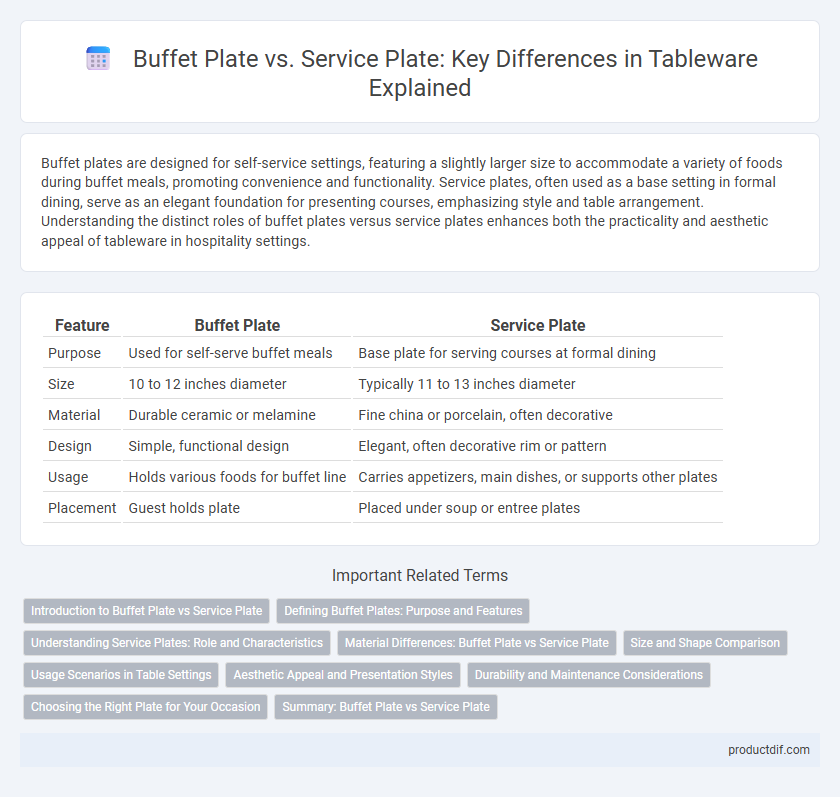Buffet plates are designed for self-service settings, featuring a slightly larger size to accommodate a variety of foods during buffet meals, promoting convenience and functionality. Service plates, often used as a base setting in formal dining, serve as an elegant foundation for presenting courses, emphasizing style and table arrangement. Understanding the distinct roles of buffet plates versus service plates enhances both the practicality and aesthetic appeal of tableware in hospitality settings.
Table of Comparison
| Feature | Buffet Plate | Service Plate |
|---|---|---|
| Purpose | Used for self-serve buffet meals | Base plate for serving courses at formal dining |
| Size | 10 to 12 inches diameter | Typically 11 to 13 inches diameter |
| Material | Durable ceramic or melamine | Fine china or porcelain, often decorative |
| Design | Simple, functional design | Elegant, often decorative rim or pattern |
| Usage | Holds various foods for buffet line | Carries appetizers, main dishes, or supports other plates |
| Placement | Guest holds plate | Placed under soup or entree plates |
Introduction to Buffet Plate vs Service Plate
Buffet plates are larger, designed to hold a variety of foods and encourage self-service during buffet-style meals, typically measuring around 11 to 13 inches in diameter. Service plates, also known as charger plates, are decorative bases placed beneath dinner plates to enhance table presentation and are not used for serving food directly, generally ranging from 12 to 14 inches in size. The primary distinction lies in the functional purpose: buffet plates facilitate food selection and consumption, while service plates serve as elegant table settings that frame the main plates.
Defining Buffet Plates: Purpose and Features
Buffet plates are designed for self-service dining settings, featuring a larger size and slightly raised edges to accommodate a variety of foods without spillage. Typically measuring between 10 to 12 inches in diameter, buffet plates prioritize functionality and ease of use during extended meals or social gatherings. Their sturdy construction often includes materials such as melamine or heavy-duty ceramic to withstand frequent handling and multiple food items.
Understanding Service Plates: Role and Characteristics
Service plates, also known as charger plates, serve as an elegant base setting for main course dinnerware, enhancing presentation at formal dining events. Typically measuring 12-14 inches in diameter, these plates remain on the table throughout the meal, providing a decorative foundation rather than for direct food service. Unlike buffet plates, which are smaller and designed for self-service portions, service plates focus on aesthetics and table setting structure.
Material Differences: Buffet Plate vs Service Plate
Buffet plates are typically crafted from durable materials like melamine or heavy-duty plastic to withstand frequent handling and high-volume use, whereas service plates are often made from fine china, porcelain, or bone china to complement formal dining settings. The material choice for buffet plates prioritizes functionality and resilience, while service plates emphasize elegance and refinement with smooth, glossy finishes. These material differences affect not only the aesthetic appeal but also the weight and durability suited to their respective dining purposes.
Size and Shape Comparison
Buffet plates typically measure between 10 to 12 inches in diameter, designed for holding a variety of foods during self-service settings, featuring a round or slightly oval shape with raised edges to prevent spills. Service plates, also known as charger plates, are larger, usually ranging from 12 to 14 inches, with a flat surface and decorative design intended to serve as a base for dinner plates during formal dining. The size difference allows buffet plates to be practical for easy handling and serving, while service plates provide an aesthetic foundation enhancing table presentation.
Usage Scenarios in Table Settings
Buffet plates are designed for self-service settings where guests select and carry multiple dishes, providing ample space for varied food items and easy handling. Service plates, also known as charger plates, serve a decorative role in formal table settings as an underplate, supporting the presentation of multiple course plates without direct contact with food. Buffet plates enhance practicality and convenience in casual or buffet-style dining, whereas service plates contribute to elegance and structure in multi-course, sit-down meals.
Aesthetic Appeal and Presentation Styles
Buffet plates showcase a versatile, minimalist design optimized for self-serve settings, emphasizing ease of access and efficient portioning, enhancing the visual appeal of diverse food arrays. Service plates, or charger plates, offer a refined, often ornate aesthetic that elevates formal dining presentations by framing dinnerware and complementing the table setting's overall elegance. Both plate types contribute distinctly to tableware aesthetics, with buffet plates highlighting practicality and service plates accentuating sophistication and ceremonial style.
Durability and Maintenance Considerations
Buffet plates are typically made from durable materials like melamine or heavy-duty plastics designed for frequent handling and easy cleaning, making them ideal for large-scale serving environments. Service plates, often ceramic or fine china, require more careful maintenance to avoid chipping and staining, reflecting their use in formal dining settings. Understanding the distinct durability and upkeep needs of each plate type ensures optimal longevity and performance in buffet versus service applications.
Choosing the Right Plate for Your Occasion
Buffet plates are designed for casual, self-serve dining, offering ample space to accommodate a variety of foods, making them ideal for buffet-style events. Service plates, also known as charger plates, serve as an elegant base setting that holds smaller dinnerware during formal meals without direct food contact. Selecting the right plate depends on the occasion's formality and functional needs, with buffet plates suited for practicality and service plates enhancing presentation.
Summary: Buffet Plate vs Service Plate
Buffet plates are typically larger and designed to hold multiple food items for self-service at buffet-style meals, emphasizing practicality and convenience. Service plates, also known as charger plates, serve as decorative bases under dinnerware during formal dining, enhancing table aesthetics without direct contact with food. Understanding the distinct roles of buffet and service plates optimizes tableware selection for both casual and elegant dining settings.
Buffet Plate vs Service Plate Infographic

 productdif.com
productdif.com